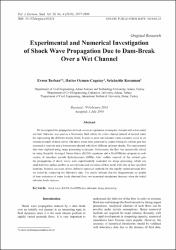| dc.contributor.author | Turhan, Evren | |
| dc.contributor.author | Özmen-Çağatay, Hatice | |
| dc.contributor.author | Kocaman, Selahattin | |
| dc.date.accessioned | 12.07.201910:50:10 | |
| dc.date.accessioned | 2019-07-12T22:05:57Z | |
| dc.date.available | 12.07.201910:50:10 | |
| dc.date.available | 2019-07-12T22:05:57Z | |
| dc.date.issued | 2019 | |
| dc.identifier.citation | Turhan, E., Ozmen-Cagatay, H., Kocaman, S. (2019). Experimental and numerical investigation of shock wave propagation due to dam-break over a wet channel. Polish Journal of Environmental Studies
28(4), 2877-2888.
https://doi.org/10.15244/pjoes/92824 | en_US |
| dc.identifier.issn | 1230-1485 | |
| dc.identifier.issn | 2083-5906 | |
| dc.identifier.uri | https://doi.org/10.15244/pjoes/92824 | |
| dc.identifier.uri | https://hdl.handle.net/20.500.12508/596 | |
| dc.description | WOS: 000467051900034 | en_US |
| dc.description.abstract | We investigated the propagation of shock waves in a prismatic rectangular channel with a horizontal wet bed. Saltwater was used as a Newtonian fluid within the entire channel instead of normal water for representing the different density fluids. It aims to point out seawater where tsunamis occur as an extreme example of shock waves. The shock waves were generated by sudden lifting of a vertical gate that separated a reservoir and a downstream channel with three different tailwater depths. The experimental data were digitized using image processing techniques. Furthermore, the flow was numerically solved by using Reynolds Averaged Navier-Stokes (RANS) equations and a DualSPHysics program (a code version of smoothed particle hydrodynamics (SPH)). After sudden removal of the vertical gate the propagations of shock waves were experimentally examined via image processing, which can yield both free surface profiles at several times and variations of flow depth with time at four specified locations. Solution successes of two different numerical methods for this rapidly varied unsteady flow are tested by comparing the laboratory data. The results indicate that the disagreements on graphs of time evolutions of water levels obtained from two numerical simulations decrease when the initial tailwater levels increase. | en_US |
| dc.description.sponsorship | Cukurova University Research Fund Project [FDK-2015-4887] | en_US |
| dc.description.sponsorship | This study was supported by Cukurova University Research Fund Project No. FDK-2015-4887. The authors gratefully acknowledge this support. | en_US |
| dc.language.iso | eng | en_US |
| dc.publisher | HARD Publishing Company | en_US |
| dc.relation.isversionof | 10.15244/pjoes/92824 | en_US |
| dc.rights | info:eu-repo/semantics/openAccess | en_US |
| dc.subject | Shock wave | en_US |
| dc.subject | RANS | en_US |
| dc.subject | DualSPHysics | en_US |
| dc.subject | Saltwater | en_US |
| dc.subject | Image processing | en_US |
| dc.subject.classification | Environmental Sciences | en_US |
| dc.subject.classification | Finite volume method | Equations of motion | Volume scheme | en_US |
| dc.subject.other | Smoothed particle hydrodynamics | en_US |
| dc.subject.other | Initial-stages | en_US |
| dc.subject.other | Simulation | en_US |
| dc.subject.other | Impact | en_US |
| dc.subject.other | Flows | en_US |
| dc.title | Experimental and Numerical Investigation of Shock Wave Propagation Due to Dam-Break Over a Wet Channel | en_US |
| dc.type | article | en_US |
| dc.relation.journal | Polish Journal of Environmental Studies | en_US |
| dc.contributor.department | Mühendislik ve Doğa Bilimleri Fakültesi -- İnşaat Mühendisliği Bölümü | en_US |
| dc.identifier.volume | 28 | en_US |
| dc.identifier.issue | 4 | en_US |
| dc.identifier.startpage | 2877 | en_US |
| dc.identifier.endpage | 2888 | en_US |
| dc.relation.publicationcategory | Makale - Uluslararası Hakemli Dergi - Kurum Öğretim Elemanı | en_US |
| dc.contributor.isteauthor | Kocaman, Selahattin | en_US |
| dc.relation.index | Web of Science - Scopus | en_US |
| dc.relation.index | Web of Science Core Collection - Science Citation Index Expanded | en_US |
















